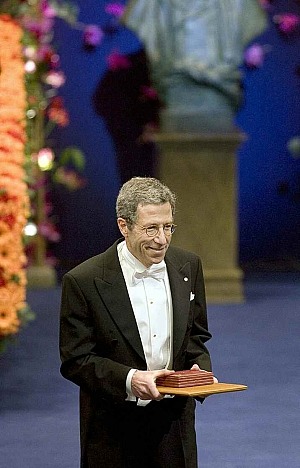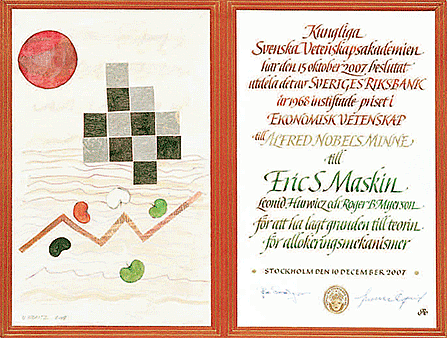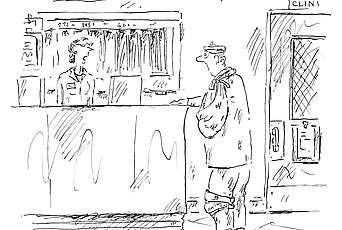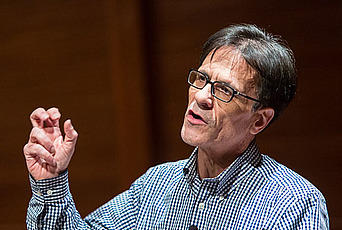Eric S. Maskin Awarded Nobel Prize in Economics

Upon receiving the Nobel Prize in Economics on December 10, 2007, Eric S. Maskin, Albert O. Hirschman Professor in the School of Social Science, became the fifth Faculty member––following Albert Einstein, Tsung-Dao Lee, Chen Ning Yang, and Frank Wilczek––in the Institute for Advanced Study’s history to become a Nobel Laureate. Many Members affiliated with the Institute have also been recognized with the Nobel Prize, among them John Nash, who was awarded the Prize in Economics in 1994. The Royal Swedish Academy of Sciences lauded Maskin for having laid the foundations of mechanism design alongside Leonid Hurwicz of the University of Minnesota and Roger B. Myerson of the University of Chicago. At the Nobel ceremonies in December, King Carl X VI Gustaf of Sweden presented Maskin with the diploma depicted above along with the Nobel medal. In his presentation speech, Jörgen Weibull, chairman of the Economics Prize Committee, cited Hurwicz, Maskin, and Myerson for having “enabled economists not only to study the performance of existing economic institutions but also to suggest how these can be improved, and to identify the theoretical limits to what can be achieved when we take into account the constraints that emanate from individuals’ incentives and private information.” In particular, Weibull congratulated Maskin for his “pioneering work on implementation theory, that part of the theory of mechanism design which deals with the problem of the potential coexistence of inferior equilibria along with the desired ones.” Weibull likewise recognized Maskin’s “numerous other important contributions, both to the pure theory of mechanism design and to its application to areas such as auctions, monopoly, and social choice.”
In his Nobel banquet speech in Stockholm on December 10, 2007, Eric S. Maskin, Albert O. Hirschman Professor in the School of Social Science, quoted Robert Kennedy: “Some men see things as they are and ask why. I dream of things that never were and ask why not.” Kennedy’s first line, according to Maskin, describes positive economics, which “explains economic events that have happened or, better yet, forecasts what will happen.”
But Kennedy’s second line, said Maskin, “captures the part of economics dearest to me: normative economics, the study of the things that never were but ought to be.” In particular, the latter describes mechanism design, for which Maskin was awarded the 2007 Sveriges Riksbank Prize in Economic Sciences in Memory of Alfred Nobel, alongside Leonid Hurwicz, whose pioneering work in mechanism design inspired Maskin to become an economist, and Roger B. Myerson, a former classmate at Harvard University with whom Maskin has collaborated.
Maskin describes mechanism design as the engineering part of economic theory that, like Kennedy, aspires to address how things ought to be rather than how they are. In other words, it reverses the direction of positive, or predictive, economics. “We start with the particular social or economic goals that we want to achieve, and then we ask, ‘What kinds of institutions, mechanisms, or games could we design to achieve those goals?’”
Over more than four decades, mechanism design theory has played a central role in many areas of economics and political science with application to auction design, pollution control, public utility regulation, privatization, voting rules, and electoral systems. Used in labor negotiations, taxation, and pricing stock options, mechanism design works to align individual incentives with desired social outcomes when not everyone has the same information or goals.
In a recent interview with the Institute Letter, Maskin recalled being intrigued by the then-nascent field as a mathematics student at Harvard University in the 1970s, when it appealed to his desire to help improve the world. “I was a product, in a way, of the late 1960s and early 1970s when students were interested in overturning the status quo,” said Maskin. “I wasn’t a revolutionary by any means, but I was certainly influenced by that way of thinking.”
Born in New York City in 1950, Maskin was raised in Alpine, New Jersey, where he attended a three-room schoolhouse and was drawn to music and mathematics at an early age. His mother was a concert pianist and his father an amateur violinist turned medical doctor. As a child, Maskin began playing the piano, then moved on to the clarinet, which he continues to play today, including a performance at the Institute in 2006. His brother is a professional oboist and English horn player with the Charlotte Symphony.
A leading economist whose work has been drawn on extensively by researchers in industrial organization, finance, development, and other fields in economics and political science, Maskin explores many areas of economic theory in addition to mechanism design, including game theory and social choice theory. Much of his current research focuses on the theory of coalition formation, comparing different voting systems, the theory of repeated games, and the pros and cons of intellectual property rights.
Maskin joined the Faculty of the Institute’s School of Social Science in 2000, after fifteen years as a professor at Harvard University, where he earned his A.B., A.M., and Ph.D. Before his Harvard appointment, Maskin taught at M.I.T. from 1977 to 1984, where he gave the economics department’s first class on game theory.
As a student at Harvard in the early 1970s, Maskin wandered, almost by accident, into an information economics course taught by Kenneth Arrow. Today Maskin describes the course as a seminal influence in his decision to become an economist. “A large component of the course was devoted to the work of Leo Hurwicz and mechanism design theory,” said Maskin. “I thought it was really exciting. I liked the fact that it was rigorous––that is, all of the concepts were carefully, in fact, mathematically defined and the arguments were often quite beautiful and sophisticated. At the same time, the content seemed socially highly relevant. I felt it was important.”
While the origins of mechanism design thought can be traced to the nineteenth century, the modern theory in large part grew out of a debate dating from the 1930s between Oskar Lange and Abba Lerner on the one hand and Friedrich von Hayek and Ludwig von Mises on the other. “Lange and Lerner put forward the view that central planning, at least potentially, could replicate markets and perhaps even surpass them by correcting market failures,” Maskin explained. “On the other side, von Hayek and von Mises were very skeptical of the idea that central planning could ever work well.”
The debate involved terms––such as centralization, decentralization, command economy, and market economy––that were not adequately defined at the time. Hurwicz was the first to give unambiguous definitions for all of the important concepts that arose in that debate, according to Maskin, and he also led the way in showing how technical tools, such as game theory and mathematical programming, could give some answers to the issues that the debate posited.
Fascinated by Hurwicz’s ideas about creating mechanisms to achieve social goals, Maskin struggled to address the following questions: “When can we implement social goals? If they are implementable, what mechanisms will do the trick? And finally, which social goals are not implementable?”
In the mid-1970s, Maskin arrived at a key concept for implementation at a very general level. In recognizing his work with the Nobel Prize in Economics, the Swedish Academy singled out a paper, “Nash Equilibrium and Welfare Optimality,” that identified a property of social goals called “monotonicity” as necessary and almost sufficient for their implementability. “If a social goal violates monotonicity, then no mechanism can implement it," said Maskin. “But if it satisfies monotonicity, then provided another (weak) condition holds, implementing mechanisms will exist. Indeed, the paper shows how you can actually design such mechanisms.”

Maskin first presented the paper at the summer workshop of the Econometric Society in Paris in June 1977. Its impact on the field was immediate and profound, so much so that he delayed actually publishing it until 1999, when it appeared in the Review of Economic Studies. “People were interested because mechanism design was such a hot topic,” Maskin recalled. “Previous work had been looking at particular social goals and asking, ‘Can this particular social goal be implemented?’ Now I was giving a general answer that would apply to any social goal.”
In the planned economy versus free market debate between Lange and Lerner and von Hayek and von Mises, mechanism design provides a broader perspective. “I think the consensus now in the economics profession is that for certain kinds of goods, you can’t really beat free markets, but those goods tend to be private goods that individual citizens consume,” said Maskin. “For public goods, like clean air or national security or a stable climate, there are good theoretical reasons why markets will not work well. For those goods, alternative mechanisms—not necessarily involving central planning— have to be found, and it was that imperative, I think, that inspired Leo Hurwicz.”
At a basic level, mechanism design theory engages game theoretic tools to make truth and honesty compatible with individual incentives. “It’s not that people are fundamentally untruthful. There is actually a lot of evidence that suggests they are remarkably honest, but unfortunately we often can’t depend on honesty when it comes to economic matters,” said Maskin. “Particularly where the stakes are high, people will have incentives to exaggerate in one direction or another, to overstate or understate. The challenge is to find mechanisms that eliminate the incentive to misstate.”


